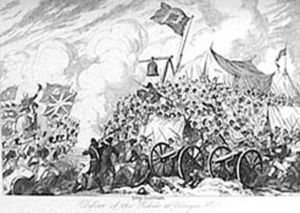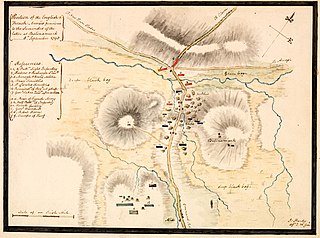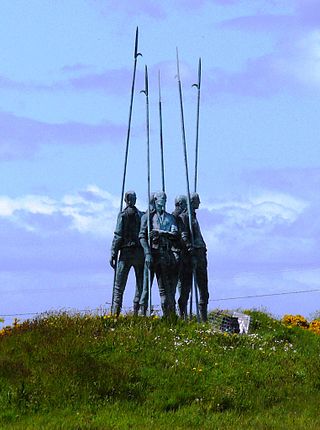| |||||
| Centuries: | |||||
|---|---|---|---|---|---|
| Decades: | |||||
| See also: | Other events of 1798 List of years in Ireland | ||||
Events from the year 1798 in Ireland.
| |||||
| Centuries: | |||||
|---|---|---|---|---|---|
| Decades: | |||||
| See also: | Other events of 1798 List of years in Ireland | ||||
Events from the year 1798 in Ireland.


The Irish Rebellion of 1798 was a popular insurrection against the British Crown in what was then the separate, but subordinate, Kingdom of Ireland. The main organising force was the Society of United Irishmen. First formed in Belfast by Presbyterians opposed to the landed Anglican establishment, the Society, despairing of reform, sought to secure a republic through a revolutionary union with the country's Catholic majority. The grievances of a rack-rented tenantry drove recruitment.

Gerard Lake, 1st Viscount Lake was a British general. He commanded British forces during the Irish Rebellion of 1798 and later served as Commander-in-Chief of the military in British India.

The Battle of Vinegar Hill was a military engagement during the Irish Rebellion of 1798 on 21 June 1798 between a force of approximately 13,000 government troops under the command of Gerard Lake and 16,000 United Irishmen rebels led by Anthony Perry. The battle, a major rebel defeat, took place on 21 June 1798 on a large rebel camp on Vinegar Hill and in the streets of Enniscorthy, County Wexford and marked the last major attempt by the rebels to hold and control territory taken in Wexford.

The Carnew executions refer to the summary execution of 28 prisoners being held as suspected United Irishmen by yeomanry troops from the Carnew garrison stationed in the barracks of Carnew Castle, County Wicklow, Ireland on 25 May 1798.
The Battle of Ballyellis on 30 June 1798 was a clash during the Irish Rebellion of 1798, between a surviving column of the dispersed Wexford rebel army and pursuing British forces which resulted in a victory for the rebels.

The second Battle of Arklow took place during the Irish Rebellion of 1798 on 9 June when a force of United Irishmen from Wexford, estimated at 10,000 strong, launched an assault into County Wicklow, on the British-held town of Arklow, in an attempt to spread the rebellion into Wicklow and to threaten the capital of Dublin.

The Battle of Castlebar was a military engagement of the Irish Rebellion of 1798 which occurred on 27 August 1798 near the town of Castlebar, County Mayo. A combined force of 2,000 French Revolutionary Army troops and United Irishmen rebels routed a British Crown force of 6,000 men mainly consisting of Irish militiamen led by Gerard Lake, 1st Viscount Lake in what would later become known as the "Castlebar Races" or "Races of Castlebar".
Anthony Perry, known as the "screeching general" was one of the most important leaders of the United Irish Wexford rebels during the 1798 rebellion.

The Battle of Ballinamuck marked the defeat of the main force of the French incursion during the 1798 Rebellion in Ireland.
The battle of Ovidstown was a military engagement between British Crown forces and United Irishmen rebels during the Irish Rebellion of 1798 near the town of Kilcock, County Kildare. Despite the initial failures experienced by the United Irishmen in County Kildare during the first months of the rebellion, the consolidation of government forces in the town of Naas and the priority given by the Dublin Castle administration to suppress the Wexford Rebellion in County Wexford meant that much of the county remained in rebel hands since the outbreak of the rebellion. Towns such as Prosperous and Clane were in rebel hands, while towns such as Maynooth, Kilcock and Kildare had been attacked and briefly occupied by the rebels. By 19 June, however, neighbouring County Meath had been judged sufficiently pacified to allow for government forces to be dispatched from that county into Kildare to recapture rebel-held territory.
John Moore was an Irishman appointed in August 1798 "President of the Government of the Province of Connacht" by the commander of a French invasion force, General Humbert.
The Dunlavin Green executions was summary execution of 36 suspected United Irishmen rebels in County Wicklow, Ireland by the Irish Yeomanry shortly after the outbreak of the rebellion of 1798. There are several accounts of the events, recorded at differing times and differing in detail.

John Murphy was an Irish Roman Catholic priest of the Roman Catholic Diocese of Ferns, who is mainly remembered for his central role in the Irish Rebellion of 1798 in County Wexford, which is sometimes known as the Wexford Rebellion. He led the rebels to one of their initial victories over a government militia at Oulart Hill, and in the following weeks became one of the rebellion's main leaders.

Bartholomew Teeling was an Irish military officer and nationalist who was the leader of the rebel forces during the Irish Rebellion of 1798 and who carried out an act of bravery during the Battle of Collooney. He was captured at the Battle of Ballinamuck and subsequently executed for treason.

The Battle of Collooney, also called the Battle of Carricknagat, refers to a battle which occurred on 5 September during the Irish Rebellion of 1798 when a combined force of French troops and Irish rebels defeated a force of British troops outside of Collooney near Sligo Town.

The Wexford Rebellion refers to the events of the Irish Rebellion of 1798 in County Wexford. From 27 May until 21 June 1798, Society of United Irishmen rebels revolted against British rule in the county, engaging in multiple confrontations with Crown forces. The most successful and destructive rising in all the counties of Ireland, United Irishmen rebels experienced a number of early successes in the county despite being seen as a relatively loyal county by the Dublin Castle administration due to a series of military victories. However, the tide soon turned against the United Irishmen in Wexford as Crown forces poured into the region, engaging in a brutal counterinsurgency which indiscriminately targeted suspected rebels and eventually suppressed all rebel activities in the county.

The battle of Ballynahinch was a military engagement of the Irish Rebellion of 1798 between a force of roughly 4,000 United Irishmen rebels led by Henry Munro and approximately 2,000 government troops under the command of George Nugent. After rebel forces had occupied Newtownards on 9 June, they gathered the next day in the surrounding countryside and elected Munro as their leader, who occupied Ballyhinch on 11 June. Nugent led a column of government troops in 12 June which recaptured the town and bombarded rebel positions. On the next day, the rebels attacked Ballyhinch, but were driven back and defeated.

British General Charles Cornwallis, the 1st Marquess Cornwallis was appointed in June 1798 to serve as both Lord Lieutenant of Ireland and Commander-in-Chief of Ireland, the highest civil and military posts in the Kingdom of Ireland. He held these offices until 1801.

The Irish Republic of 1798, more commonly known as the Republic of Connacht, was a short-lived state proclaimed during the Irish Rebellion of 1798 that resulted from the French Revolutionary Wars. A sister republic of the French Republic, it theoretically covered the whole island of Ireland, but its functional control was limited to only very small parts of the Province of Connacht. Opposing British forces were deployed across most of the country including the main towns such as Dublin, Belfast and Cork.
The Battle of Kilthomas took place on 27 May 1798 when combined Loyalist Forces defeated a gathering of several thousand rebels in the greater Ferns/Carnew area, in one of the primary actions of the rebellion in County Wexford. This occurred at the same time as the Battle of Oulart Hill in the east of the county.